1. Creating a user account and assigning responsibilities
In System Administrator Responsibility> Security>User>Define
Enter a Username and Password
Assign the following responsibilities:
• System Administrator
• Application Developer
• Receivables Manager
• Collections Agent
• Collections Forms Administrator
• CRM Resource Manager
• Collections HTML Admin
• Telesales Agent
• Human Resources Manager
• CRM Administrator
2. Setting up an Employee
• Navigate to HR Responsibility
• Setup employee
• People>Enter & Maintain
• Enter name, birthday, gender, SSN and Save
• Note the employee number
3. Attach the employee name to the user name
• Navigate to System Administrator Responsibility
• Security>User>Define
• Query your Username
• Enter the Full Name as it appeared in the HR setup screen above
• Save
4. Create a group
a. Navigation : CRM Resource Manager -> Maintain Resources -> Groups
b. Name/Start Date (you can use anything)
c. -Assign Usages
i. Collections
d. -Roles
e. Collections Agent
Test Dunning Group
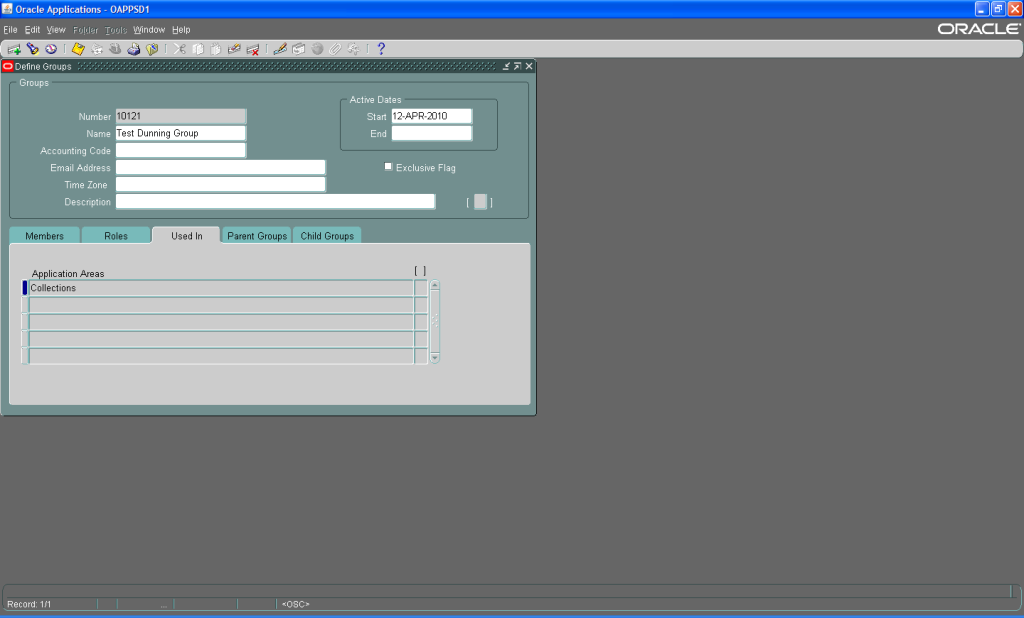

5. Import Resource
a. Navigation : CRM Resource Manager -> Maintain Resources -> Import Resources
b. Resource Cat = Employee
c. Enter Employee # that was noted previously
d. Click search/select employee
e. Click start import
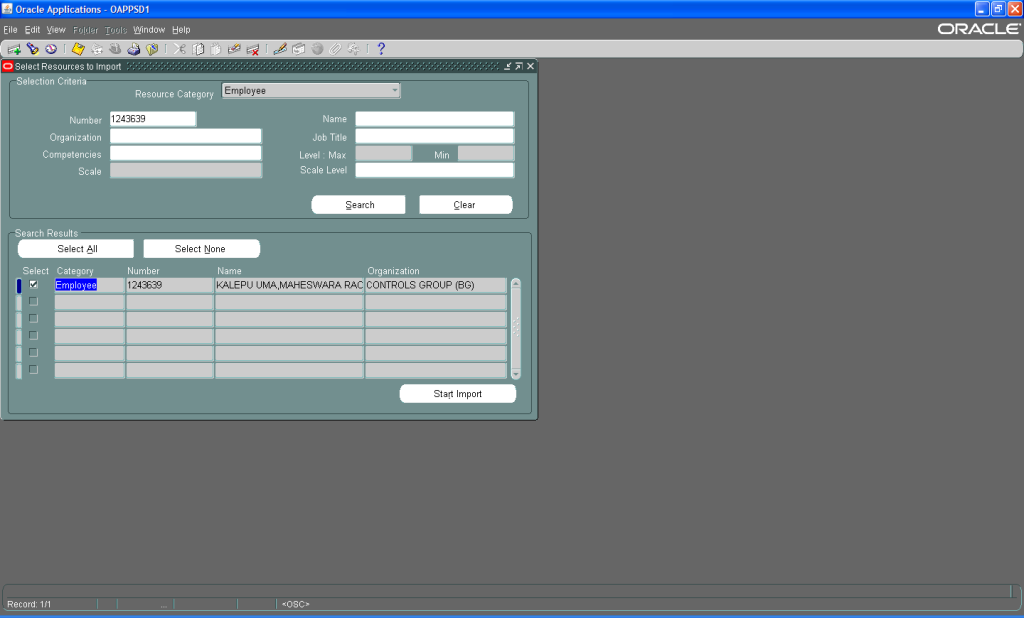
f. select start date of the resource
g. Click OK.

h. Save Resource.
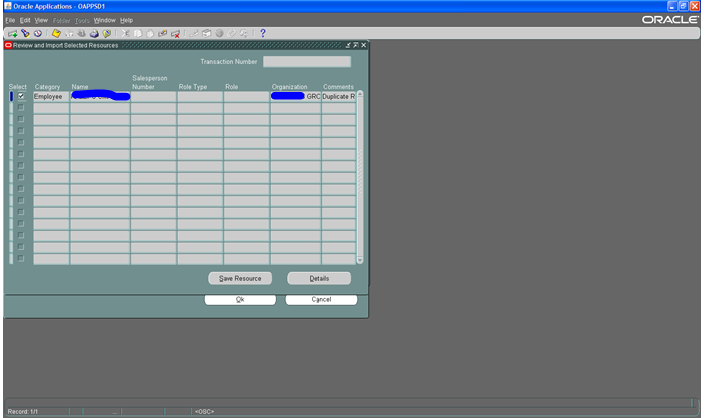
i. Click Details
j. From the Resource Management Form, enter the Username
k. Click on Roles Tab (Security & Access)
Add the following roles:
Collections Role Type
Collections Agent Role

l. Click on the Group Tab
Query Group you created previously
Close the form
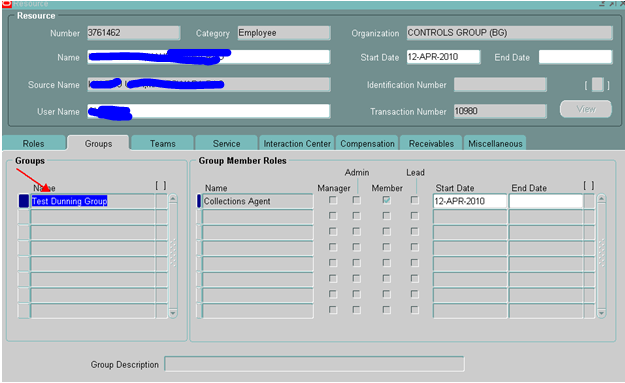
m. Add yourself as an employee to the group
Close the form.

——————————————-
1. Changing Data Template
a. Navigate to: XML Publisher Administrator
b. Click on Data Definition tab

c. Search for: Collection XML Data Source
d. Update the template you want to use for your dunning letters
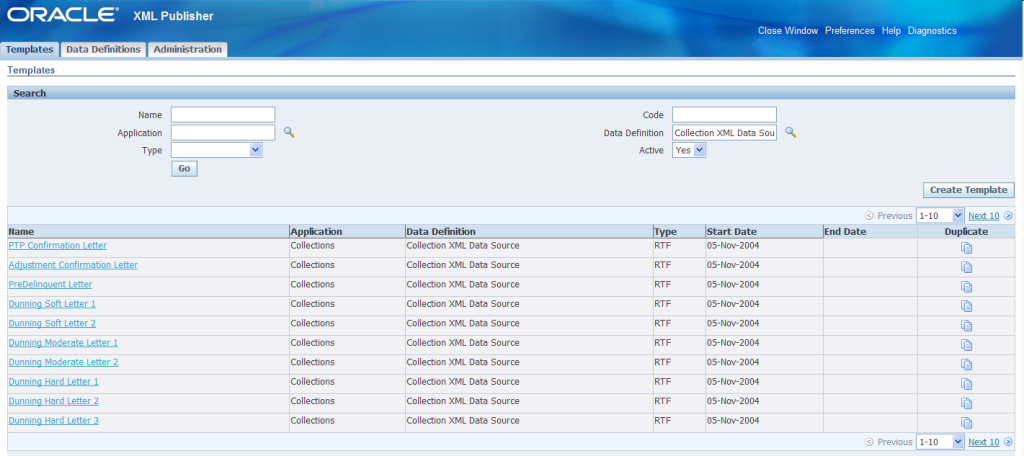
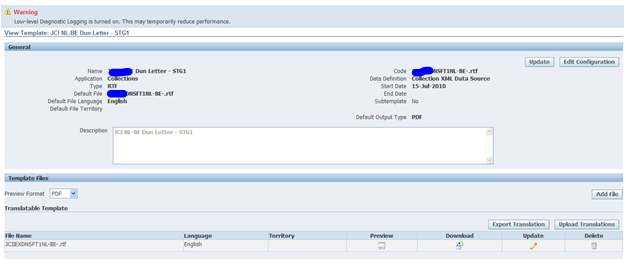
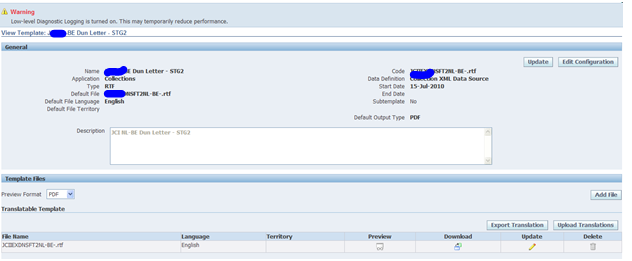

e. Manage Template query
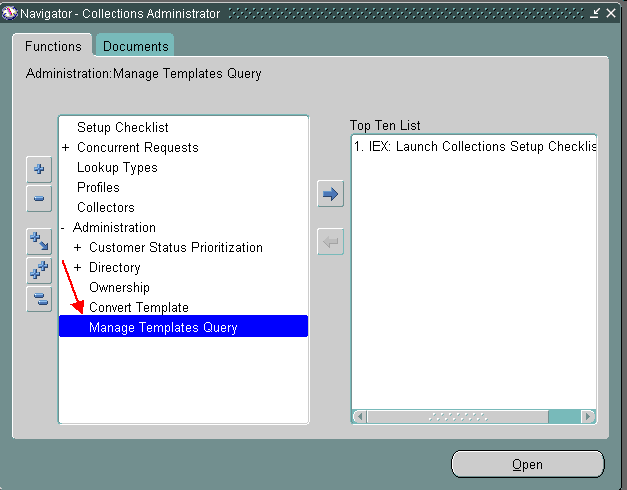

XXX -NL-BE Dun Letter – STG1
XXX -NL-BE Dun Letter – STG2
XXX -NL-BE Dun Letter – STG3

select to_char(sysdate, ‘MM/DD/YYYY’) currsysdate,
decode((per.person_first_name || per.person_last_name), null, ARPT_SQL_FUNC_UTIL.get_lookup_meaning(‘RESPONSIBILITY’, ‘APS’), per.person_first_name) first_name,
per.person_last_name last_name,
org.party_name org_name,
loc.address1 address1,
loc.address2 address2,
loc.city city,
loc.state state,
loc.postal_code postal_code,
per.person_first_name first_name1,
(select sum(aps.amount_due_remaining)
from
iex_delinquencies_all dd,
ar_payment_schedules_all aps
where
dd.payment_schedule_id = aps.payment_schedule_id and
dd.party_cust_id = org.party_id and
dd.cust_account_id = :ACCOUNT_ID and
dd.customer_site_use_id = :CUSTOMER_SITE_USE_ID) total_amount_due_remaining,
to_char(sysdate+14, ‘MM/DD/YYYY’) required_pay_date,
rs.source_name collector_name,
rs.source_job_title collector_title,
rs.source_phone collector_phone,
cursor
(select
ct.trx_number invoice_number,
to_char(ar.due_date, ‘MM/DD/YYYY’) due_date,
ar.amount_due_remaining amount_due_remaining
from
iex_delinquencies_all d,
ar_payment_schedules_all ar,
ra_customer_trx_all ct
where
d.party_cust_id = org.party_id
and d.cust_account_id = :ACCOUNT_ID
and d.customer_site_use_id = :CUSTOMER_SITE_USE_ID
and d.payment_schedule_id = ar.payment_schedule_id
and d.status = ‘DELINQUENT’
and ar.customer_trx_id = ct.customer_trx_id
and ar.amount_due_remaining <> 0
) as payment_history
from
HZ_LOCATIONS loc
,hz_parties org
,hz_parties per
,jtf_rs_resource_extns rs
where
loc.location_id = :LOCATION_ID
and org.party_id= :PARTY_ID
and per.party_id = nvl(:CONTACT_ID, org.party_id)
and rs.RESOURCE_ID = :RESOURCE_ID
f. SELECT TEMPLATE_ID, APPLICATION_ID, TEMPLATE_CODE, TEMPLATE_NAME FROM XDO_TEMPLATES_VL WHERE TEMPLATE_NAME LIKE ‘%MyTemplateName%';
g. Verify reference exist between XDO Template and Collections Query
SELECT * FROM IEX_QUERY_TEMP_XREF WHERE TEMPLATE_ID = <MyTemplateID>;
h. Review the existing queries in the table based on Dunning Level(Strategy level) in this case, we are using BillTo.
SELECT QUERY_ID, DESCRIPTION from IEX_XML_QUERIES WHERE OBJECT_TYPE = ‘DUNN’ AND QUERY_LEVEL = ‘BILL_TO;
i. Insert into row into IEX_QUERY_TEMP_XREF table connecting Template and Query Use the sequence value from IEX_QUERY_TEMP_XREF_S for QUERY_TEMP_ID
Receivables -> Setup -> Collections -> Aging Buckets
XXX Aging Bucket

2. Setting up for Dunning Plans
a. Navigation: Collections Administrator -> Setup Checklist
b. Click on Home tab

c. Click on Edit Questionnaire for Operations Setup
d. Check the Bill To radio button and check box for collection / dunning level

e. Click Next leave default.
f. Click Next.
g. Click on Dunning Plan radio button for collections method

3. Create Scoring Components
a. Navigation: Collections Administrator -> Setup Checklist -> Click on tab Collections Method Setup
b. Click on Create Scoring Component

c. Give a name
d. Enable the check box
e. Select type as Bill To
f. Select Value Type as Select Statement
g. Give any valid SQL

XXX Dunning Comp
SELECT NVL(MAX(ABL.BUCKET_SEQUENCE_NUM),0)
FROM AR_AGING_BUCKETS AB
,AR_AGING_BUCKET_LINES ABL
,AR_PAYMENT_SCHEDULES ARP
,IEX_DELINQUENCIES DEL
WHERE ABL.AGING_BUCKET_ID = AB.AGING_BUCKET_ID
AND AB.BUCKET_NAME = ‘XXX Aging Bucket’
AND DEL.PAYMENT_SCHEDULE_ID = ARP.PAYMENT_SCHEDULE_ID
AND (TRUNC(SYSDATE) – TRUNC(ARP.DUE_DATE)) BETWEEN ABL.DAYS_START AND ABL.DAYS_TO
AND DEL.STATUS IN (‘DELINQUENT’, ‘PREDELINQUENT’)
AND ARP.STATUS =’OP’
AND DEL.CUSTOMER_SITE_USE_ID = :BILLTO_ID
h. Click on apply.
4. Create Scoring Engine
a. Click on Create scoring Engine tab under Collections Method Setup
b. Click on Create Scoring Engine button

c. Fill up the form as in screen shot and click next
XXX Dunning Scoring engine

d. Click on Add Score Component
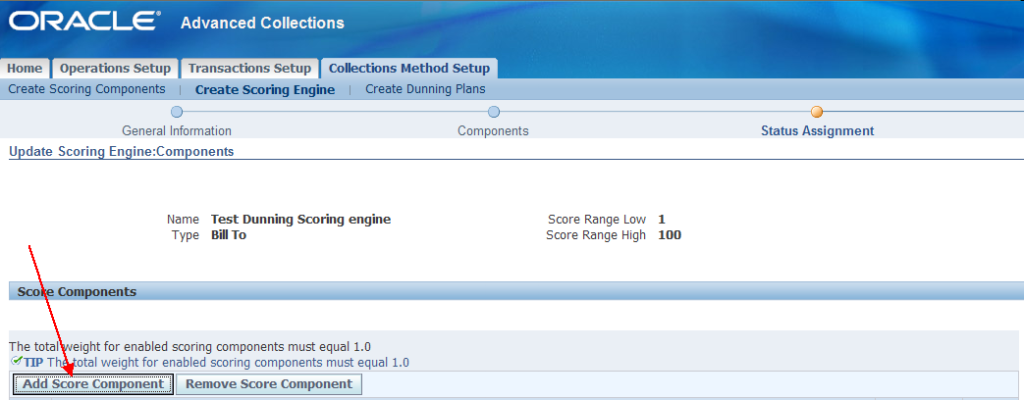
e. Search you Scoring Component and select it

f. Key in the weight for that component and click on recalculate button
g. Define ranges for you component and click next
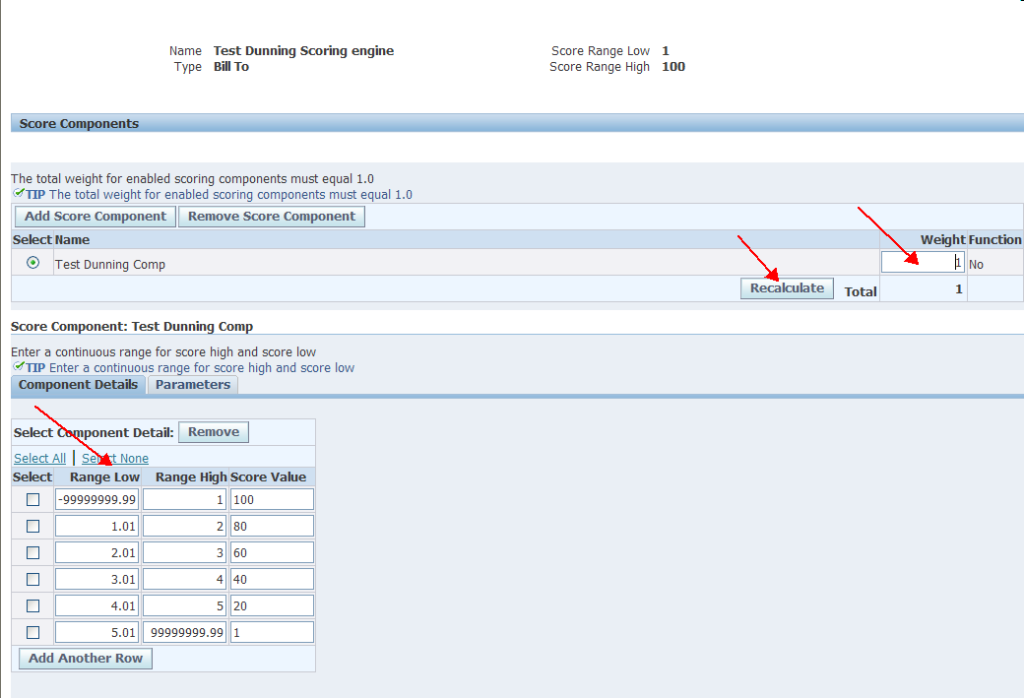
h. Define segments and click next
IEX_F_BILLTO_V

5. Create Dunning Plans
a. Go to create dunning plans tab under Collections Method Setup

b. Fill in the form and select the aging bucket you want to use for this dunning plan, click next
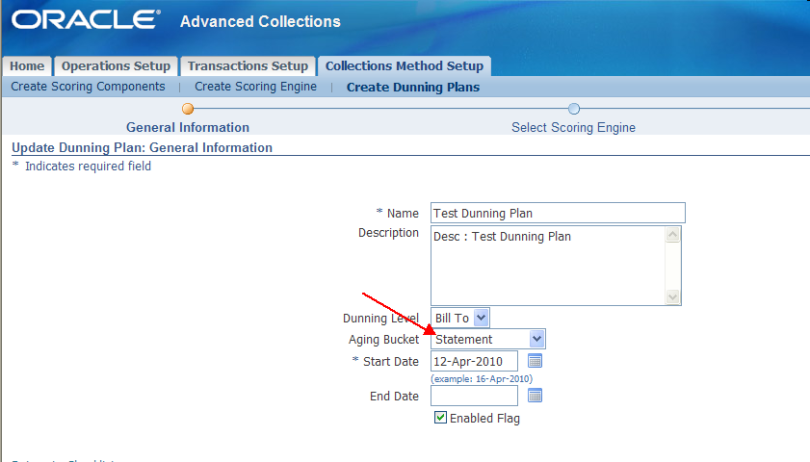
Dunning Plan
c. Select the scoring engine you created and click next

d. Define your dunning plan as per the score and assign dunning letter template and click next

e. Click finish

6. Define Contacts with dunning purpose
7. Running Concurrent Programs
• IEX: Scoring Engine Harness:
You can select up to five scoring engines to run at the same time. The scoring harness assigns a value to an object such as a customer, account, or bill to location. Another score determines whether transactions are delinquent, pre-delinquent, or current. At a minimum, you must run a scoring engine that scores transactions to create delinquencies; and then run a scoring engine to score the level of your dunning plan (customer, account, or bill to location).
Set
• IEX: Collections Bucket profile for your aging bucket.
• IEX: Send Dunnings for delinquent customers:
This program sends the results of the scoring engine harness to Oracle One-to-One Fulfillment to send out dunning
correspondence
IEX: Purge Score History Table
The concurrent program IEX: Score History Purge: Purges historical data stored in the IEX_SCORE_HISTORIES table. Run this program if you do not use historical data.
The parameters:
a) Score Object ID: This parameter will clean up score history for a single object, ‘Customer/Account/Site/Transaction’. For example if you pick a customer you can say to clean all scores for customer = ‘Business World’.
b) Score Object Code: This parameter will clean up all the history for the type of objects. For example, you can set it to clean up all scores for transactions.
c) Request ID: This parameters will clean up all the scores generated by a concurrent program request. If you ran a concurrent program with a scoring engine and did not like the result, you can basically wipe it clean by entering the request id.
d) The recommendation is for administrator to run this at least once a week to clean up transaction histories. OR to run this and leave all the fields blank and only select ‘Save Last Run’ = ‘Y’, which will cause the concurrent program to clean all the score history for all objects BUT it will leave the last score created for each object. So if you run scoring for customers for a year, if you use this option all the scores except the last one for each of your customers will be deleted.
In System Administrator Responsibility> Security>User>Define
Enter a Username and Password
Assign the following responsibilities:
• System Administrator
• Application Developer
• Receivables Manager
• Collections Agent
• Collections Forms Administrator
• CRM Resource Manager
• Collections HTML Admin
• Telesales Agent
• Human Resources Manager
• CRM Administrator
2. Setting up an Employee
• Navigate to HR Responsibility
• Setup employee
• People>Enter & Maintain
• Enter name, birthday, gender, SSN and Save
• Note the employee number
3. Attach the employee name to the user name
• Navigate to System Administrator Responsibility
• Security>User>Define
• Query your Username
• Enter the Full Name as it appeared in the HR setup screen above
• Save
4. Create a group
a. Navigation : CRM Resource Manager -> Maintain Resources -> Groups
b. Name/Start Date (you can use anything)
c. -Assign Usages
i. Collections
d. -Roles
e. Collections Agent
Test Dunning Group


5. Import Resource
a. Navigation : CRM Resource Manager -> Maintain Resources -> Import Resources
b. Resource Cat = Employee
c. Enter Employee # that was noted previously
d. Click search/select employee
e. Click start import

f. select start date of the resource
g. Click OK.

h. Save Resource.

i. Click Details
j. From the Resource Management Form, enter the Username
k. Click on Roles Tab (Security & Access)
Add the following roles:
Collections Role Type
Collections Agent Role

l. Click on the Group Tab
Query Group you created previously
Close the form

m. Add yourself as an employee to the group
Close the form.

——————————————-
1. Changing Data Template
a. Navigate to: XML Publisher Administrator
b. Click on Data Definition tab

c. Search for: Collection XML Data Source
d. Update the template you want to use for your dunning letters




e. Manage Template query


XXX -NL-BE Dun Letter – STG1
XXX -NL-BE Dun Letter – STG2
XXX -NL-BE Dun Letter – STG3

select to_char(sysdate, ‘MM/DD/YYYY’) currsysdate,
decode((per.person_first_name || per.person_last_name), null, ARPT_SQL_FUNC_UTIL.get_lookup_meaning(‘RESPONSIBILITY’, ‘APS’), per.person_first_name) first_name,
per.person_last_name last_name,
org.party_name org_name,
loc.address1 address1,
loc.address2 address2,
loc.city city,
loc.state state,
loc.postal_code postal_code,
per.person_first_name first_name1,
(select sum(aps.amount_due_remaining)
from
iex_delinquencies_all dd,
ar_payment_schedules_all aps
where
dd.payment_schedule_id = aps.payment_schedule_id and
dd.party_cust_id = org.party_id and
dd.cust_account_id = :ACCOUNT_ID and
dd.customer_site_use_id = :CUSTOMER_SITE_USE_ID) total_amount_due_remaining,
to_char(sysdate+14, ‘MM/DD/YYYY’) required_pay_date,
rs.source_name collector_name,
rs.source_job_title collector_title,
rs.source_phone collector_phone,
cursor
(select
ct.trx_number invoice_number,
to_char(ar.due_date, ‘MM/DD/YYYY’) due_date,
ar.amount_due_remaining amount_due_remaining
from
iex_delinquencies_all d,
ar_payment_schedules_all ar,
ra_customer_trx_all ct
where
d.party_cust_id = org.party_id
and d.cust_account_id = :ACCOUNT_ID
and d.customer_site_use_id = :CUSTOMER_SITE_USE_ID
and d.payment_schedule_id = ar.payment_schedule_id
and d.status = ‘DELINQUENT’
and ar.customer_trx_id = ct.customer_trx_id
and ar.amount_due_remaining <> 0
) as payment_history
from
HZ_LOCATIONS loc
,hz_parties org
,hz_parties per
,jtf_rs_resource_extns rs
where
loc.location_id = :LOCATION_ID
and org.party_id= :PARTY_ID
and per.party_id = nvl(:CONTACT_ID, org.party_id)
and rs.RESOURCE_ID = :RESOURCE_ID
f. SELECT TEMPLATE_ID, APPLICATION_ID, TEMPLATE_CODE, TEMPLATE_NAME FROM XDO_TEMPLATES_VL WHERE TEMPLATE_NAME LIKE ‘%MyTemplateName%';
g. Verify reference exist between XDO Template and Collections Query
SELECT * FROM IEX_QUERY_TEMP_XREF WHERE TEMPLATE_ID = <MyTemplateID>;
h. Review the existing queries in the table based on Dunning Level(Strategy level) in this case, we are using BillTo.
SELECT QUERY_ID, DESCRIPTION from IEX_XML_QUERIES WHERE OBJECT_TYPE = ‘DUNN’ AND QUERY_LEVEL = ‘BILL_TO;
i. Insert into row into IEX_QUERY_TEMP_XREF table connecting Template and Query Use the sequence value from IEX_QUERY_TEMP_XREF_S for QUERY_TEMP_ID
Receivables -> Setup -> Collections -> Aging Buckets
XXX Aging Bucket

2. Setting up for Dunning Plans
a. Navigation: Collections Administrator -> Setup Checklist
b. Click on Home tab

c. Click on Edit Questionnaire for Operations Setup
d. Check the Bill To radio button and check box for collection / dunning level

e. Click Next leave default.
f. Click Next.
g. Click on Dunning Plan radio button for collections method

3. Create Scoring Components
a. Navigation: Collections Administrator -> Setup Checklist -> Click on tab Collections Method Setup
b. Click on Create Scoring Component

c. Give a name
d. Enable the check box
e. Select type as Bill To
f. Select Value Type as Select Statement
g. Give any valid SQL

XXX Dunning Comp
SELECT NVL(MAX(ABL.BUCKET_SEQUENCE_NUM),0)
FROM AR_AGING_BUCKETS AB
,AR_AGING_BUCKET_LINES ABL
,AR_PAYMENT_SCHEDULES ARP
,IEX_DELINQUENCIES DEL
WHERE ABL.AGING_BUCKET_ID = AB.AGING_BUCKET_ID
AND AB.BUCKET_NAME = ‘XXX Aging Bucket’
AND DEL.PAYMENT_SCHEDULE_ID = ARP.PAYMENT_SCHEDULE_ID
AND (TRUNC(SYSDATE) – TRUNC(ARP.DUE_DATE)) BETWEEN ABL.DAYS_START AND ABL.DAYS_TO
AND DEL.STATUS IN (‘DELINQUENT’, ‘PREDELINQUENT’)
AND ARP.STATUS =’OP’
AND DEL.CUSTOMER_SITE_USE_ID = :BILLTO_ID
h. Click on apply.
4. Create Scoring Engine
a. Click on Create scoring Engine tab under Collections Method Setup
b. Click on Create Scoring Engine button

c. Fill up the form as in screen shot and click next
XXX Dunning Scoring engine

d. Click on Add Score Component

e. Search you Scoring Component and select it

f. Key in the weight for that component and click on recalculate button
g. Define ranges for you component and click next

h. Define segments and click next
IEX_F_BILLTO_V

5. Create Dunning Plans
a. Go to create dunning plans tab under Collections Method Setup

b. Fill in the form and select the aging bucket you want to use for this dunning plan, click next

Dunning Plan
c. Select the scoring engine you created and click next

d. Define your dunning plan as per the score and assign dunning letter template and click next

e. Click finish

6. Define Contacts with dunning purpose
7. Running Concurrent Programs
• IEX: Scoring Engine Harness:
You can select up to five scoring engines to run at the same time. The scoring harness assigns a value to an object such as a customer, account, or bill to location. Another score determines whether transactions are delinquent, pre-delinquent, or current. At a minimum, you must run a scoring engine that scores transactions to create delinquencies; and then run a scoring engine to score the level of your dunning plan (customer, account, or bill to location).
Set
• IEX: Collections Bucket profile for your aging bucket.
• IEX: Send Dunnings for delinquent customers:
This program sends the results of the scoring engine harness to Oracle One-to-One Fulfillment to send out dunning
correspondence
IEX: Purge Score History Table
The concurrent program IEX: Score History Purge: Purges historical data stored in the IEX_SCORE_HISTORIES table. Run this program if you do not use historical data.
The parameters:
a) Score Object ID: This parameter will clean up score history for a single object, ‘Customer/Account/Site/Transaction’. For example if you pick a customer you can say to clean all scores for customer = ‘Business World’.
b) Score Object Code: This parameter will clean up all the history for the type of objects. For example, you can set it to clean up all scores for transactions.
c) Request ID: This parameters will clean up all the scores generated by a concurrent program request. If you ran a concurrent program with a scoring engine and did not like the result, you can basically wipe it clean by entering the request id.
d) The recommendation is for administrator to run this at least once a week to clean up transaction histories. OR to run this and leave all the fields blank and only select ‘Save Last Run’ = ‘Y’, which will cause the concurrent program to clean all the score history for all objects BUT it will leave the last score created for each object. So if you run scoring for customers for a year, if you use this option all the scores except the last one for each of your customers will be deleted.
Regards,
ReplyDeleteHarish
Oracle technical and fusion cloud SCM online classes, if you are interested please whatsapp to this number +91 7382582893, thank you.
Good Work Elango...Thanks a lot for your great help!
ReplyDeleteVery Nice, thanks!
ReplyDeleteMay i know how the email send to the delinquent customer. Could you elabrate that process.
ReplyDeleteBihar School Education Board has released the 12th Model Papers for the year 2022. (BSEB). The question papers from prior years are available in pdf format. Students studying for Inter examinations should practise model or sample papers to gain a sense of Bihar Board 10th Model Paper 2022 the types of questions that will be asked. They will gain familiarity with the marking structure and amount of questions by solving BSEB 12th model paper 2022. Furthermore, completing these Model papers in the allotted time will aid pupils in boosting their problem-solving speed.
ReplyDelete